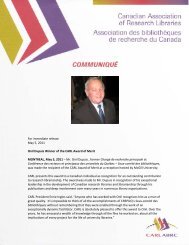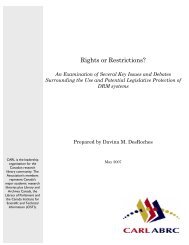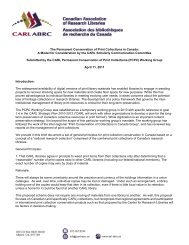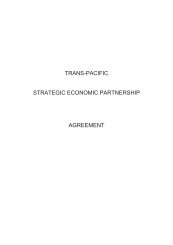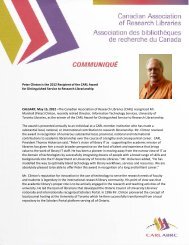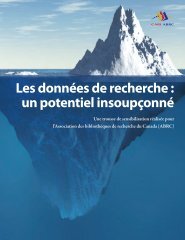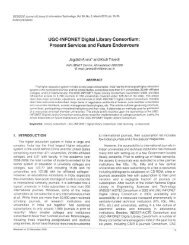PDF - CARL - ABRC
PDF - CARL - ABRC
PDF - CARL - ABRC
You also want an ePaper? Increase the reach of your titles
YUMPU automatically turns print PDFs into web optimized ePapers that Google loves.
21. Cynthia Shelton, “Best Practices in Cooperative Collection Development:<br />
A Report Prepared by the Center for Research Libraries<br />
Working Group on Best Practices in Cooperative Collection<br />
Development,” Collection Management 28 (2004): 191–222.<br />
22. Scott Seaman, “Collaborative Collection Management in a High-<br />
Density Storage Facility,” College & Research Libraries 66 (2005):<br />
20–27 and Knoche, “Critical Factors.”<br />
23. Shelton, “Best Practices,” p. 205.<br />
24. Seaman, “Collaborative collection management,” p. 21.<br />
25. Ibid., p. 26.<br />
26. Shelton, “Best Practices,” p. 208.<br />
27. David C. Tyler, and Bryan L. Pytlig Zillig, “Caveat Relocator: A<br />
Practical Relocation Proposal to Save Space and Promote Electronic<br />
Resources.” Technical Services Quarterly 21 (2003): 17-30, 21.<br />
28. Richard Kaplan, Marilyn Steinberg, and Joanne Doucette, “Retention<br />
of Retrospective Print Journals in the Digital Age: Trends and<br />
Analysis,” Journal of the Medical Library Association: JMLA 94 (Oct<br />
2006): 387–393.<br />
29. Jill Newby, “An Emerging Picture of Mathematicians’ Use of<br />
Electronic Resources: The Effect of Withdrawal of Older Print<br />
Volumes,” Science & Technology Libraries 25 (2005): 65–85.<br />
30. James P. McCarthy, “The Print Block and the Digital Cylinder,”<br />
Library Management 26, (2005): 89-96, 92.<br />
31. Harriet Bell, The Value of Online Journal Backfiles to University<br />
Libraries. Online. Elsevier ScienceDirect. (2005) Available: http://<br />
info.sciencedirect.com/content/backfiles/optimizing_backfiles/<br />
(April 28, 2009).<br />
32. Steve McKinzie, “Op Ed – Troubling Choices: Full-text Access and the<br />
Old Hard Copy Back Runs,” Against the Grain 17 (2005): 60-1, 61.<br />
33. Newby, “An Emerging Picture,” p. 75.<br />
34. Yvonne Carignan, “Who Wants Yesterday's Papers? The Faculty<br />
Answer,” Collection Management 31 (2006): 75–84.<br />
35. John McDonald, “‘No One Uses Them So Why Should We Keep<br />
Them?': Scenarios for Print Issue Retention,” Against the Grain 15<br />
(2003): 22-4, 24.<br />
36. Stephen G. Nichols et al., The Evidence in Hand: Report of the Task<br />
Force on the Artifact in Library Collections, CLIR pub103,<br />
Washington, DC: CLIR, November 2001.<br />
37. Schottlaender, “Collection Management Strategies.”<br />
38. Carolyn Henebry, Ellen Safley, and Sarah E. George, “Before You<br />
Cancel the Paper, Beware: All Electronic Journals in 2001 are NOT<br />
Created Equal,” Serials Librarian 42 (2002): 267–273.<br />
39. Walt Crawford, “Here's the Content - Where's the Context?,”<br />
American Libraries 31 (Mar 2000): 50–52.<br />
40. Beth Weston and Deena Acton, “Managing Divergence of Print and<br />
Electronic Journals,” Serials Librarian 56 (2009): 181–198.<br />
41. Jacquelyn Marie Erdman, “Image Quality in Electronic Journals: A<br />
Case Study of Elsevier Geology Titles,” Library Collections, Acquisitions,<br />
& Technical Services 30 (2006): 169–178.<br />
42. Newby, “An Emerging Picture,” p. 75.<br />
43. Marianne Stowell Bracke and Jim Martin, “Developing Criteria for<br />
the Withdrawal of Print Content Available Online,” Collection<br />
Building 24 (2005): 61–64.<br />
44. Ibid., p. 61.<br />
45. Ibid., p. 63.<br />
46. ScienceDirect, Backfiles Re-Scanning Project. Online. Elsevier B.V.<br />
(N.D.) Available: http://info.sciencedirect.com/content/backfiles/<br />
optimizing_backfiles/ (April 28, 2009).<br />
47. JSTOR, JSTOR Bound Volume Survey Results. Online. (2003)<br />
Available: http://www.jstor.org/page/info/about/news/surveys/<br />
bvs2003.jsp.<br />
48. Brian Jablonski. 2006 Bound Volume Survey Results. (email to<br />
HeinOnline mailing list) Online. (October 10,2006) Available:<br />
http://lists.washlaw.edu/pipermail/heinonline/2006-October/<br />
000244.html (April 28, 2009) Selected or comprehensive discarding<br />
and whether it includes any sort of agreement with other<br />
institutions for access to print was not investigated in this survey.<br />
49. Portico/Ithaka, Digital Preservation of E-journals in 2008:<br />
Urgent Action Revisited. Results from a Portico/Ithaka Survey<br />
of U.S. Library Directors. Online. (2008) Available: http://<br />
www.portico.org/comment/wp-content/uploads/2008/05/<br />
porticosurveyondigitalpreservation.pdf (April 29, 2009).<br />
50. Ibid., p. 5.<br />
51. Andrew Waller and Gwen Bird, “We own it: Dealing with<br />
perpetual access in big deals,” Serials Librarian 50 (2006):<br />
179–196.<br />
52. McKinzie, “Op ed,” p. 61.<br />
53. Sadie L. Honey, “Preservation of Electronic Scholarly Publishing:<br />
An Analysis of Three Approaches,” Portal: Libraries & the Academy<br />
5 (2005): 59-75, 59.<br />
54. McKinzie, “Op ed,” p. 61.<br />
55. Peter Monaghan, “Critics Balk at Withdrawal of Journal from<br />
Archive,” Chronicle of Higher Education 54. (8) (2007): A1–A12.<br />
56. Andrew Albanese, “Science Rejoins JSTOR,” Library Journal 133<br />
(2008): 16.<br />
57. Scholars Portal (www.scholarsportal.info) consists of roughly<br />
8,100 full-text journals representing eighteen commercial publishers<br />
and 130 databases from eight publishers. It hosts a singlesearch<br />
platform Illumina, an Interlibrary Loans platform RACER,<br />
and bibliographic management software RefWorks. Scholars Portal<br />
also uses the open-URL resolver SFX, and is testing an electronic<br />
resources management tool Verde . Some of the projects currently<br />
in development include the development of a new interface to<br />
replace its ejournals server, the development of a local delivery<br />
platform for electronic books, (in conjunction with ebrary) and a<br />
web-based data extraction system, the Ontario Data Documentation,<br />
Extraction Service and Infrastructure project (ODESI).<br />
58. RLG-OCLC, Trusted Digital Repositories: Attributes and Responsibilities,<br />
an RLG-OCLC Report. Online. (May 2002) Available:<br />
http://www.oclc.org/programs/ourwork/past/trustedrep/<br />
repositories.pdf (April 28, 2009).<br />
59. OCUL (http://www.ocul.on.ca/) contracted with C. Maskell to do<br />
this survey. Data was collected in the summer of 2008 and the<br />
report was submitted to the OCUL Directors at the winter 2008<br />
directors' meeting. C. Maskell wishes to express her sincere thanks<br />
to OCUL for the opportunity to do the survey and their support with<br />
it, as well as their permission to report the results of the survey.<br />
60. Two JStor repositories are at the University of California (http://<br />
www.srlf.ucla.edu/Jstor/Default.aspx) and Harvard University<br />
(http://hul.harvard.edu/hd/).<br />
61. After presentation of the report on the survey at the winter 2008<br />
OCUL directors meeting, the Thunder Bay agreement was crafted<br />
and passed by the directors. The agreement stipulates two action<br />
strategies: a. OCUL will implement a distributed model based on<br />
the coordinated retention and collaborative storage of print<br />
journals to address immediate short-term space needs. Decisionmaking<br />
will reside at the local level. It will be incumbent on<br />
individual libraries who wish to discard print journals to<br />
determine whether they hold the last OCUL print copy. If so,<br />
they are obliged to keep the volumes or find another OCUL library<br />
that will do so; and b. OCUL will explore collaboration<br />
opportunities with other regional and national organizations to<br />
determine the status of any print repositories being developed or<br />
discussed.<br />
May 2010 249



